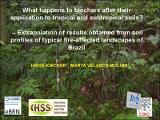Por favor, use este identificador para citar o enlazar a este item:
http://hdl.handle.net/10261/90269COMPARTIR / EXPORTAR:
 SHARE
BASE SHARE
BASE
|
|
| Visualizar otros formatos: MARC | Dublin Core | RDF | ORE | MODS | METS | DIDL | DATACITE | |

| Campo DC | Valor | Lengua/Idioma |
|---|---|---|
| dc.contributor.author | Knicker, Heike | - |
| dc.contributor.author | Velasco Molina, Marta | - |
| dc.date.accessioned | 2014-01-31T12:50:29Z | - |
| dc.date.available | 2014-01-31T12:50:29Z | - |
| dc.date.issued | 2014 | - |
| dc.identifier.citation | International Conference Biochars, Composts, and Digestates. Production, Characterization, Regulation, Marketing, Uses and Environmental Impact: (2013) | es_ES |
| dc.identifier.uri | http://hdl.handle.net/10261/90269 | - |
| dc.description | 16 páginas.-- Conferencia oral presentada en la Sesión: Small scale treatment and use of organic wastes in rural areas of tropics and subtropics.--International Conference Biochars, Composts, and Digestates.-- Celebrada del 17-20 de octubre 2013, en Bari, Italia.-- cmartin@irnase.csic.es | - |
| dc.description.abstract | Since biochar amendment has been suggested only recently as a tool to improve soil fertility, field experiments on the long-term impact of this management are scarce. However, first estimates may be available by analyzing natural soils which have been exposed to frequent fire events. Aside from the Terra preta do Indio, Brazil offers other landscapes which are characterized by frequent fires caused by human activity during the last centuries and millennia. Typical systems are the Cerrado in Central Brazil, the highlands in the Planalto of Southern Brazil and some regions of the Pantanal in the Southwest of the country. Analyzing the organic matter along soil profiles in those regions revealed the presence of charcoal residues down to the C horizons. Interestingly, lower charcoal contributions were found in the top soils than in the deeper horizons, most tentatively because of efficient charcoal oxidation at the surface and the subsequent removal of the degradation products by further mineralization or by leaching to deeper soil regions. According to solid-state NMR spectroscopy, the organic matter of several deeper horizons was almost exclusively composed of charcoal residues. This observation demonstrates their preferential preservation in deep soils, possibly supported by their stabilization through the mineral phase. Our data clearly show that frequent charcoal addition can have a long-term impact on organic matter composition of deeper soil horizons. Considering that oxidized charcoal residues may also leach into the aquifer, a further evaluation of the impact of such residues on the groundwater is urgently needed. | - |
| dc.language.iso | eng | es_ES |
| dc.publisher | CSIC - Instituto de Recursos Naturales y Agrobiología de Sevilla (IRNAS) | es_ES |
| dc.rights | openAccess | es_ES |
| dc.title | What happens to biochars after their application to tropical and subtropical soils? – Extrapolation of results obtained from soil profiles of typical fire-affected landscapes of Brazil | es_ES |
| dc.type | comunicación de congreso | es_ES |
| dc.description.peerreviewed | Peer reviewed | es_ES |
| dc.type.coar | http://purl.org/coar/resource_type/c_5794 | es_ES |
| item.openairetype | comunicación de congreso | - |
| item.grantfulltext | open | - |
| item.cerifentitytype | Publications | - |
| item.openairecristype | http://purl.org/coar/resource_type/c_18cf | - |
| item.fulltext | With Fulltext | - |
| item.languageiso639-1 | en | - |
| Aparece en las colecciones: | (IRNAS) Artículos | |
Ficheros en este ítem:
| Fichero | Descripción | Tamaño | Formato | |
|---|---|---|---|---|
| What_happens_biochars.pdf | 2,63 MB | Adobe PDF |  Visualizar/Abrir |
CORE Recommender
Page view(s)
209
checked on 22-abr-2024
Download(s)
92
checked on 22-abr-2024
Google ScholarTM
Check
NOTA: Los ítems de Digital.CSIC están protegidos por copyright, con todos los derechos reservados, a menos que se indique lo contrario.
